Why The Chronicle-Telegram’s Cease-and-Desist Letter Is Bull$hit.
Why The Chronicle-Telegram’s lawsuit threat over a freely available photo reveals their fear of criticism—and their willingness to bully a paying, disabled subscriber.
They’re threatening to sue me—a disabled Army veteran and paid subscriber—over a photo they freely published online. If I’m such a liar and a kook, why are they so afraid of my one small voice?
Yesterday I opened my mailbox and found a certified‐mail envelope from The Chronicle-Telegram’s lawyers. Their claim? I used a single still image of Chief James McCann in my April 22 Substack post—“Inside the Lorain Corruption Series: How Police Chief McCann Became the Enforcer for a City”—without permission, and they demanded I remove it immediately or face a lawsuit. At first I thought it was a prank: the photo was publicly available on their own site, and my Substack is free to everyone. I wasn’t profiting from it.
But the more I dug into the details—into U.S. copyright law and Ohio’s new anti-SLAPP statute—the clearer it got that this is about intimidation, not copyright.
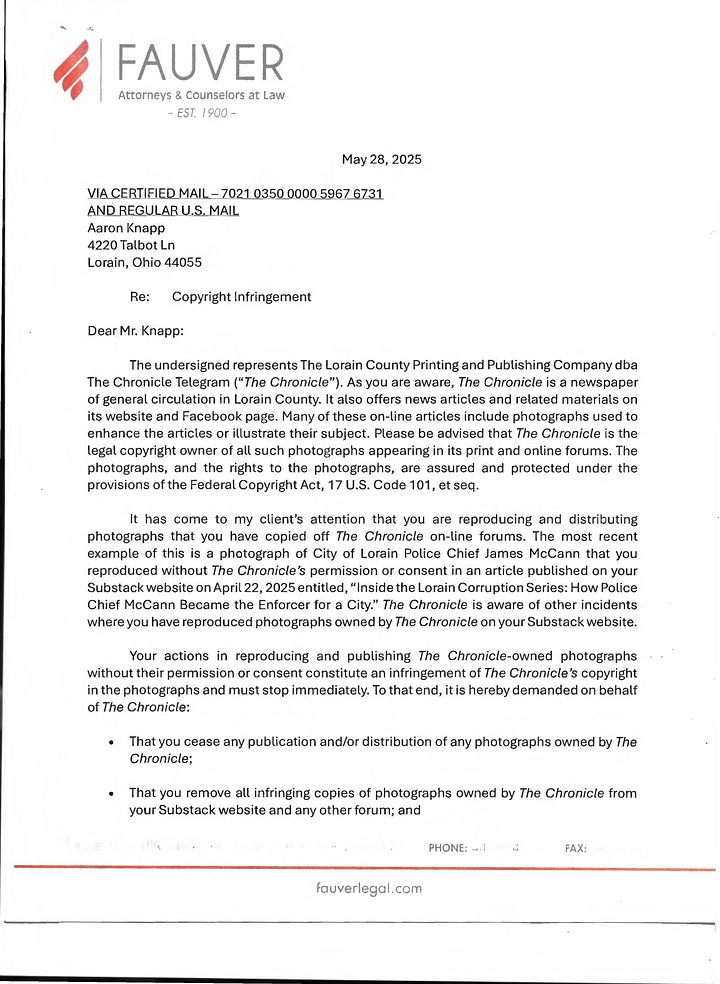

Embedding One Photo Was Fair Use
On April 22, I wrote about how Chief McCann’s public statements matched up with his department’s actions. To illustrate that, I embedded a single still shot of Chief McCann from The Chronicle’s own site. That image wasn’t decoration; it anchored my argument. My post is free, I linked back to the original, and I never charged a dime to see it.
Under U.S. copyright law, fair use allows limited reproduction of copyrighted material for commentary, news reporting, or criticism. Courts look at four factors:
The purpose and character of the use. My use was noncommercial and transformative. I wasn’t selling ad space or charging subscribers to see the photo. I used it only to critique Chief McCann’s role in local government. In Katz v. Chevaldina (11th Cir. 2015), a blogger’s satirical use of a landlord’s photo was fair use because it added new commentary. My situation is the same kind of scenario.
The nature of the copyrighted work. Photographs of public officials on duty are treated as factual, not purely creative. In Perfect 10, Inc. v. Amazon.com, Inc. (9th Cir. 2007), the Ninth Circuit held that photos of public figures have less protection when used for commentary. In Harbus v. Manhattan Institute (S.D.N.Y. 2020), a nonprofit’s small, cropped photo of Governor Cuomo in a critical essay was fair use. Embedding one still of Chief McCann—who is clearly a public figure—leans in the same direction.
Amount and substantiality. I used exactly one still frame. That’s minimal. In Righthaven v. Democratic Underground (D. Nev. 2011), quoting just five out of fifty sentences from a newspaper article (with a link back) was fair use. In Schwartzwald v. Oath, Inc. (S.D.N.Y. 2020), a court held that using a cropped portion of a photo was fair because it didn’t replace any existing licensing market. Embedding a single still in a free blog post is even more minimal.
Effect on the potential market. My Substack didn’t harm The Chronicle’s market for that photo. If anything, my link back could generate ad impressions for them. In Katz, the Eleventh Circuit found no evidence that the blogger’s satire harmed any market for the original photo. In Harbus, the court said it was “implausible” anyone would pay to license a tiny, low-res image. There’s no way my one still undercuts The Chronicle’s licensing or advertising.
Finally, the First Amendment protects noncommercial commentary about public officials. In New York Times Co. v. Sullivan (1964), the Supreme Court made clear that debate about government conduct is core speech. No newspaper can weaponize copyright to muzzle criticism of its own coverage. My post added new analysis of how Chief McCann’s statements lined up with public policy decisions. Every fair-use factor favors me.
Ohio’s Anti-SLAPP Law Has My Back
Even if someone tried to argue fair use was unclear (which it isn’t), Ohio’s new anti-SLAPP law—effective January 8, 2025—stops lawsuits meant to chill public participation. Under the Uniform Public Expression Protection Act (UPEPA), any lawsuit primarily designed to punish or intimidate someone for speaking on a public concern qualifies as a SLAPP. Once I’m served, I can file an Anti-SLAPP Motion. That motion immediately stays all discovery—no depositions, no document requests—until the court decides whether the speech is protected.
Ohio courts then ask: Is this lawsuit based on my protected speech? If it is (and it obviously is), The Chronicle must prove a “probability of success on the merits.” My fair-use defense is rock-solid, backed by Katz, Harbus, Righthaven, and Schwartzwald. If they can’t meet that burden, the court must dismiss the suit and award me attorney’s fees. If the trial court denied my motion, I can take an immediate appeal, staying the entire case until the higher court decides.
Ohio’s legislature recognized exactly the danger of letting big institutions drag local writers through endless litigation over a single image. UPEPA shuts that nonsense down. If The Chronicle honestly believed they had a valid copyright claim, they could have asked me privately to remove it or offered a licensing fee. Instead, they sent me lawyers—knowing full well that I’m a disabled Army veteran who pays for a subscription to their own paper. That is bad faith.
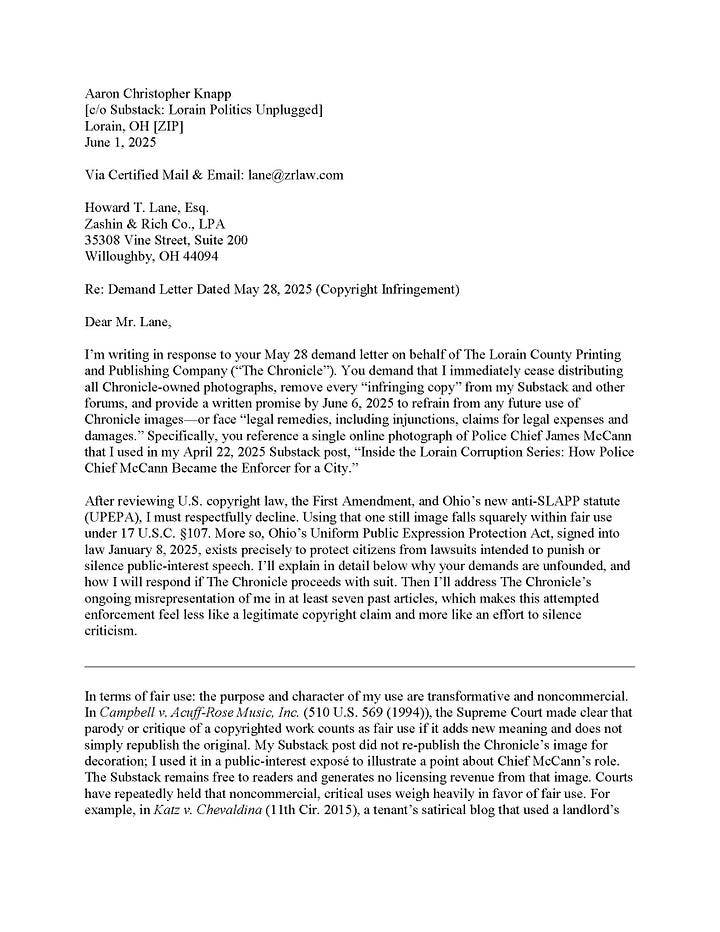
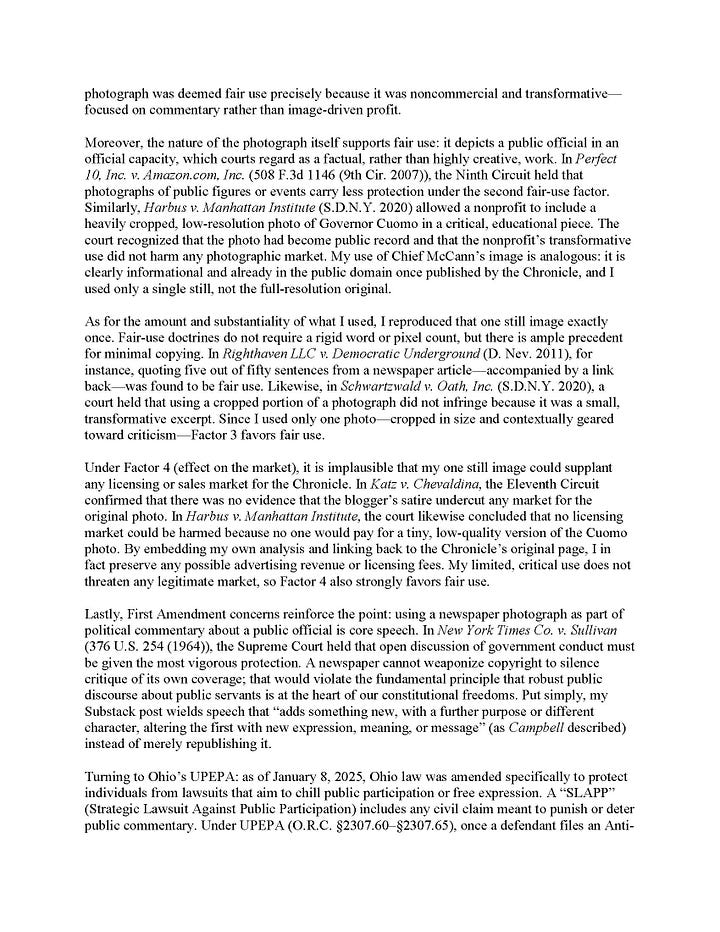
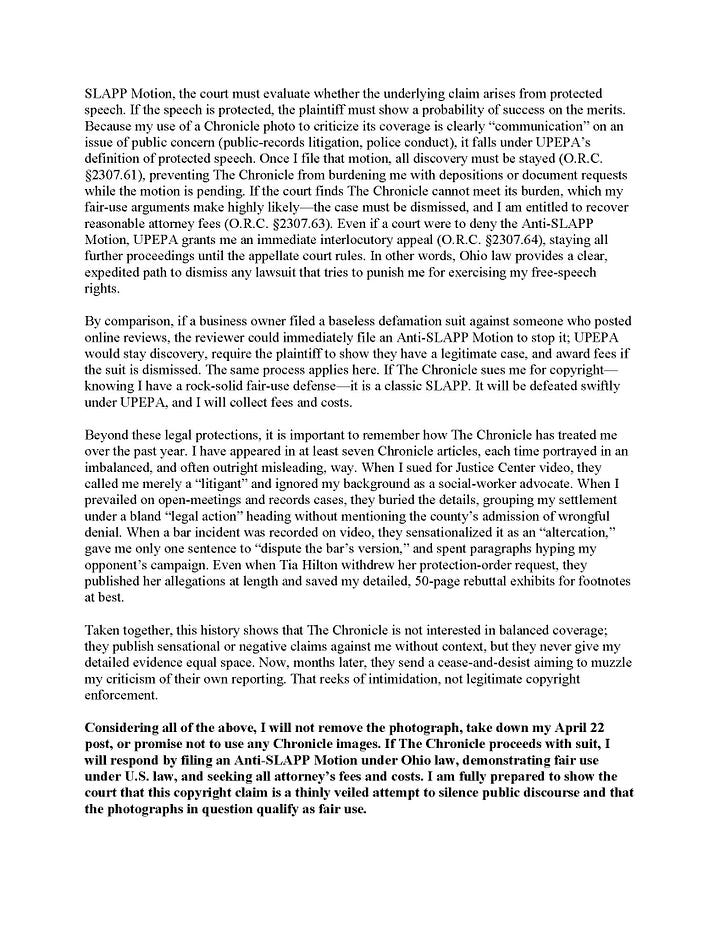
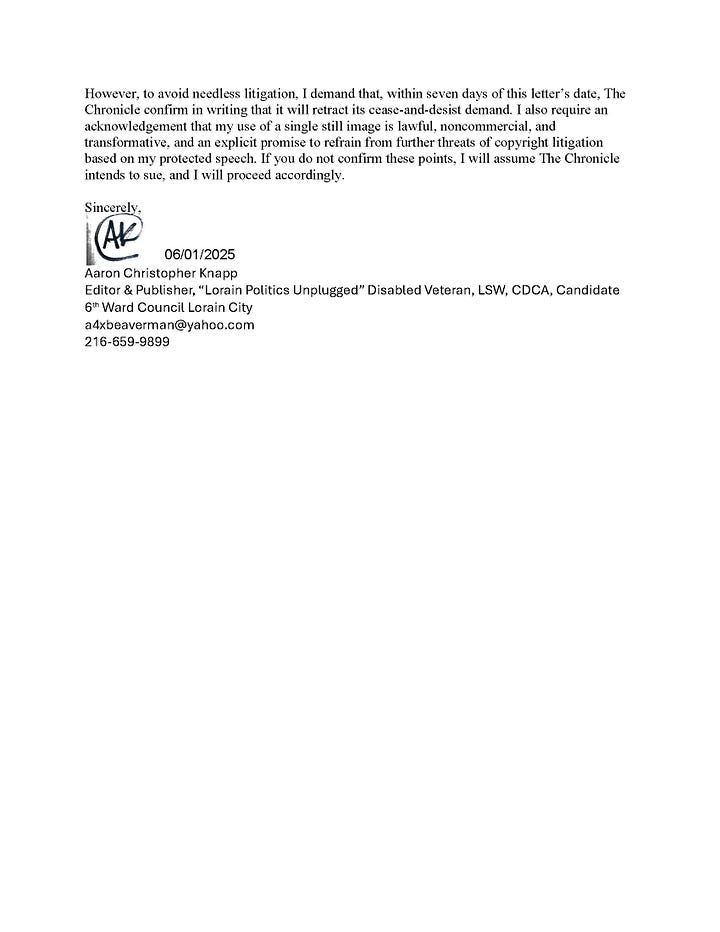
Big Paper, Little Guy
It’s hard to feel smaller than when a newspaper with a shrinking print schedule, a halved newsroom, and a shaky subscriber base sends lawyers after a disabled Army veteran. I served my country, and now I deal with PTSD, traumatic brain injuries, multiple concussion syndrome, tinnitus, and back and leg injuries every day. I spent time in uniform; and since coming home, I’ve tried to hold local officials accountable by demanding transparency. I thought my hometown paper might have my back. Instead, they’re flexing legal muscle to silence me.
I’m a paid subscriber. Every morning, I log into The Chronicle’s website to see their headlines. When they wrote me off as “a man files court action” in a public-records case, I still clicked. When they printed unverified allegations about me, I still paid for access. Why? Because I believed local journalism could hold power accountable. Now they’ve thrown me under the bus.
If paying for a subscription doesn’t buy you respect, what does? If they truly think I’m “a liar and a kook,” they’d ignore me until I faded away. Instead, they sent lawyers to threaten a wounded veteran. That’s classic intimidation.
Why They Want to Silence Me
Over the past year, The Chronicle has mischaracterized me at every turn. They’ve twisted my words and buried my evidence to make me look like a troublemaker instead of an advocate for transparency. When I sued for Justice Center video, they treated me like a random litigant, ignoring my background as a social-worker investigator exposing possible mistreatment. When I won an $8,400 settlement for open-meetings and records violations, they buried the county’s admission of wrongdoing under a bland “legal actions” update. When bar security recorded me in a scuffle, they ran a sensational “altercation” story, gave me one line—“I dispute the bar’s version of events”—and spent paragraphs hyping my opponent’s résumé. When Tia Hilton filed (then dropped) a protection order against me, The Chronicle printed her unverified allegations in full and hid my 50-page rebuttal where no one could find it.
Now they send me a cease-and-desist over a photo they published themselves. If they really believed I’m “a liar and a kook,” why are they so obsessed with silencing me?
If You Think I’m Lying, Why Sue Me?
Here’s the bottom line: embedding a single, publicly available image for commentary is textbook fair use. If The Chronicle seriously believes they have a legitimate copyright claim—or that I’m some fringe conspiracy theorist—they could have chosen to ignore me. Instead, they risk a PR disaster by suing a disabled Army veteran who still pays for their paper. That speaks volumes.
I served my country. I’m living with PTSD, TBIs, multiple concussion syndrome, tinnitus, and chronic back and leg injuries. I pay for a subscription to their newspaper. And they think it’s okay to threaten me with a lawsuit? If you’re reading this, ask yourself: if I’m so wrong, why are they afraid of what I’m writing?
How You Can Help
This is not just my fight. It’s yours too. If The Chronicle can threaten a disabled Army veteran over a one-time, noncommercial use of a photo, they can do it to anyone. Here’s how you can fight back:
Read my Substack. Look at how they misrepresent my public-records wins, twist my words, and smear my name.
Share these posts. Send them to friends, family, neighbors—anyone who cares about accountability in local journalism.
Ask questions. Whenever The Chronicle writes about me, demand context: Where are the 50 pages of TPO exhibits? Why wasn’t the county’s admission of wrongdoing mentioned?
Unsubscribe yourself. The more paid subscribers they lose, the more they’ll realize a free blog post doesn’t scare me—it inspires others.
If they really think I’m lying or out of my mind, let them prove it in court. Let them face an Ohio judge who will ask: “Why are you suing a disabled veteran? Why are you ashamed to own your reporting?”
What Happens Next
I will not remove that photo. I will not retract my April 22 post. If The Chronicle sues, I will file an Anti-SLAPP Motion in Ohio state court immediately. I will force them to prove that embedding a single still image in a free blog post is not fair use. If they can’t—spoiler: they can’t—the court will dismiss their case, award me fees, and remind every newspaper that suing veterans for speaking out is unacceptable.
Lorain deserves a newspaper that reports honestly, not one that sues paying subscribers into silence. If The Chronicle wants to be taken seriously, they’ll retract this absurd demand by June 8, 2025. They’ll admit that embedding a single, freely available image for commentary is lawful, noncommercial, and transformative. They’ll promise never to threaten me again.
Until then, I’ll keep writing—because Louvain needs to know that it’s one small voice that matters. And right now, I’m not backing down.
—Aaron Christopher Knapp
Editor & Publisher, Lorain Politics Unplugged




